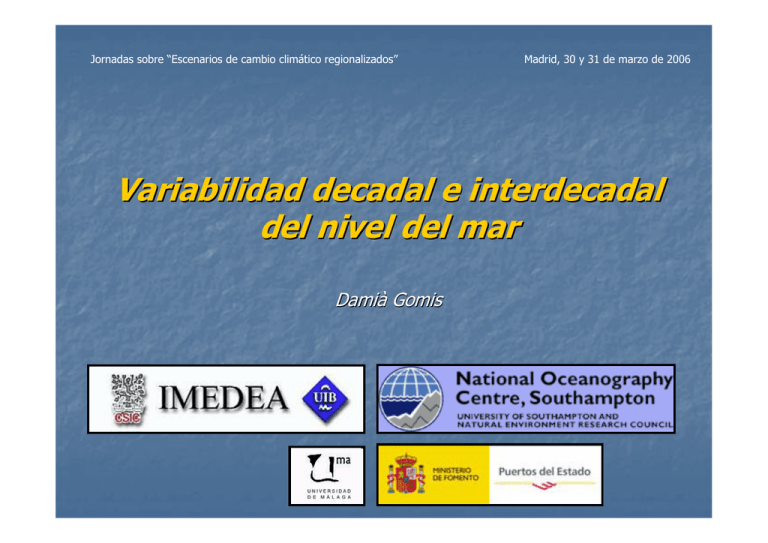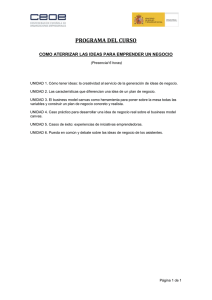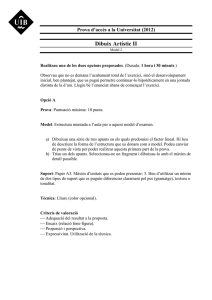Canvi climàtic: la postura dels moviments ecologistes
Anuncio

Jornadas sobre “Escenarios de cambio climático regionalizados” Madrid, 30 y 31 de marzo de 2006 Variabilidad decadal e interdecadal del nivel del mar Damià Gomis Cambio climático y nivel del mar Posibles cambios que pueden tener un impacto en las zonas costeras: - cambios en el nivel medio global (incrementos de masa/volumen) - cambios en el nivel medio regional (forzamiento atmosférico mecánico y modificación del régimen de corrientes) - cambios en la variabilidad de frecuencia media (la ‘marea meteorológica’) - cambios en el régimen de oleaje - cambios en el régimen de extremales de nivel Impactos: - inundación de zonas costeras Æ delimitaciones de dominio público - impacto sobre obra civil, especialmente en puertos - modificación del transporte de sedimentos en sistemas frágiles (dunas, playas,…) - impacto del incremento de temperatura sobre la biodiversidad -… Antecedentes: estudio de series largas Projects: - ESEAS (2002-05): towards an increase of the European sea level observation capabilities - different aspects of sea-level variability (2002-05) - different aspects of the circulation variability (2006-09) Funding: EU, Puertos del Estado. Methods: different data analysis methods: dimension reduction (EOFs), statistical approaches, … Results: - deploying of new, GPS-referenced tide gauge stations - development (and implementation in PdE procedures) of methods aimed to analyze the spatial consistency of the time series - characterization of the seasonal cycle (García-Lafuente et al., JGR, 2004) - extreme events evolution (Del Río et al, in preparation) - sea-level trends (Marcos et al., JGR, 2005) * HAMSOM model forced by a downscaling of atmospheric fields carried out by the Climate Diagnostics Centre (CDC-NOAA-CIRES). Ref.: HIPOCAS project. Numerical model* Residual (cm) 60 Observations EOF prediction CORUÑA 40 20 0 -20 -40 1-Noviembre-95 - 31-Marzo-96 (Semanas) 1 EOF 2 EOF 3 EOF Num. model Bias 3.71 1.34 2.06 5.74 Std 5.89 4.19 4.68 6.97 Maximum 35 23 37 33 (cm) Æ Correction of a ref. jump of 4 cm in the Coruña record 1943 - 2001 1993 - 2001 Relative trend (mm/year) Absolute Trend (mm/year) Post-Glacial 1.85 ± 0.09 2.12 2.38 ± 0.09 2.69 ± 0.09 Station Relative Trend (mm/year) 0.27 IEO-Santander --- 2.51 0.13 IEO-Coruña 3.78 ± 1.40 3.91 2.91 0.22 IEO-Vigo 3.30 ± 1.40 3.52 0.33 PdE-Bilbao 5.75 ± 1.31 6.08 0.27 PdE-Santander 5.59 ± 1.32 5.86 0.13 PdE-Coruña 3.94 ± 1.38 4.07 0.22 PdE-Vigo 2.65 ± 1.41 2.87 Rebound (mm/year) Absolute Trend (mm/year) --- Trabajos actuales: del “cuanto” al “ por qué ” Project: VANIMEDAT (2005-08): from the description of the variability to the quantification of the different physical forcings: thermosteric contribution, mass increase, atmospheric mechanical forcing and regional circulation changes. Reconstruction of spatial fields backwards in time. Funding: MEC. Methods: merging of different data sets: tide gauge data, satellite altimetry and model data models: - barotropic sea level model forced by a reanalysis of 44 years of downscaled atmospheric pressure/wind data - baroclinic ocean circulation model forced by the same reanalysis, but now including heat fluxes http://www.imedea.uib.es/goifis/OTROS/VANIMEDAT/html/vanimedat.htm Altimeter Tracks in the Mediterranean Sea ERS / ENVISAT TP / JASON Domains of: - the barotropic model HAMSOM (the sea-level forecasting operational model of Puertos del Estado) - the downscaled reanalysis of atmospheric fields generated by the model REMO in the framework of the HIPOCAS project. - the wave model WAM (not used in the framework of VANIMEDAT). HAMSOM outputs only reflect the contribution of direct atmospheric forcing to total sea level variability. However, this is by far the dominant contribution to sea level variability at scales between 1 day and a few months. The skill of the model has been largely validated against tide gauge data. Correlation between observed sea level residuals and model outputs is around 0.8 or higher, with RMS errors of order 5 cm. Removing the steric part from the tide gauge signal the agreement would be even better. Model Point 120 Barcelona Tide Gauge Sea level (cm) 30 20 10 0 -10 -20 0 50 100 150 200 250 300 350 1999 Year day Sea-level residuals from the Barcelona tide gauge (41º 21' 01'' N, 2º 9' 41'' E) and model values at the closest gridpoint (41º 20' 00'' N, 2º 15' 00'' E) during 1999. Atmospheric pressure/wind forcing: first EOF for each season Winter (93%) Summer (83%) Spring (91%) Autumn (85%) Amplitude of the first EOF for each season: interannual variability Western A(t) − − − A(t) = a.NAO(t) + b.t + c Total r: correlation coeficient Comparison with previous flow estimates inferred from currentmeter observations. The model only includes the meteorological forcing. Flow estimates base on some hypothesis such as the interface depth Tsimplis and Bryden [23 Jan − 23 Apr 1997] Sv Obs. Inflow Obs. Outflow Obs. Net flow Model-derived flow 2 1.5 1 0.5 0 -0.5 -1 -1.5 -2 20 30 40 50 60 70 80 90 100 110 Year day 1997 Correlation between observed and modelled net flow: Linear regression (Tobs = a*Tmod + c) coefficient: Bias between observed and modelled net flow: 0.81 0.91 0.085 Sv 120 Temporal evolution of the spatial mean of latent and sensible heat fluxes Sensible Spatial mean Heat Fluxes (W/m2) 0 60 120 180 240 Latent 300 1 month average 360 420 480 0 -10 -20 -30 -40 -50 -60 -70 -80 month (1=Jan 1958) Spatial pattern of time means Qué podemos aportar a la caracterización de escenarios regionales + Caracterización del impacto de distintos escenarios atmosféricos sobre el océano, en particular sobre: - la evolución del nivel medio del mar, cuantificando las distintas contribuciones (termoestérica, mecànica, etc.) - la evolución de la variabilidad (extremales, oleaje,…) - validaciones a corto plazo a partir de datos in situ y remotos Metodología: - modelo numérico forzado por downscalings de modelos atmosféricos (océano pasivo frente a atmósfera) - interpretación de resultados (caracterización de patrones espaciales, índices climáticos, etc.) Aplicación: - al periodo 1958-2001 en el marco de VANIMEDAT, a partir del downscaling de re-analisis; modelo barotropo y baroclino - extensión a periodos futuros si se cuenta con predicciones de modelos para escenarios futuros + Feedback oceánico sobre los escenarios atmosféricos, en particular sobre: - flujos de calor atmósfera-océano, frente a la opción de calcular los flujos a partir de climatologías marinas Metodología: - modelo numérico baroclino para acoplar a modelo atmosférico

